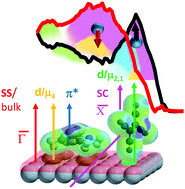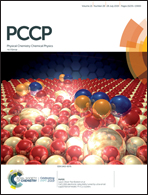Electronic and magnetic properties of a ferromagnetic cobalt surface by adsorbing ultrathin films of tetracyanoethylene†
Abstract
Ultrathin films of tetracyanoethylene (TCNE) on Co(100) were investigated by means of spin-integrated and spin-resolved photoemission spectroscopy ((sp-)UPS), X-ray photoemission spectroscopy (XPS), near edge X-ray absorption fine-structure spectroscopy (NEXAFS), and X-ray magnetic circular dichroism (XMCD). We found a coverage-dependent modulation of the interface dipole and a switching between a metallic and a resistive spin filtering at the interface triggered by two distinct adsorption geometries of TCNE. The strongest hybridization and spin structure modifications are found at low coverage with a face-on adsorption geometry indicating changes in the distance between the surface Co atoms beneath. TCNE has the potential to manipulate the magnetic moments in the Co surface itself, including the possibility of magnetic hardening effects. In summary, the system TCNE/Co offers an experimentally rather easy and controllable way to build up a stable molecular platform stabilizing the reactive ferromagnetic Co surface and customizing the electronic and magnetic properties of the resulting spinterface simultaneously. This makes this system very attractive for spintronic applications as an alternative, less reactive but highly spin polarized foundation beside graphene-based systems.



 Please wait while we load your content...
Please wait while we load your content...